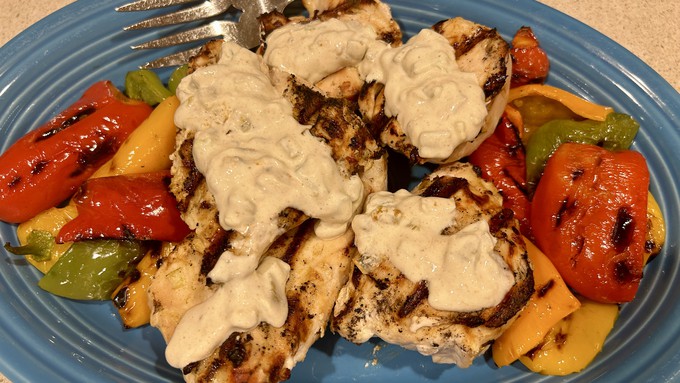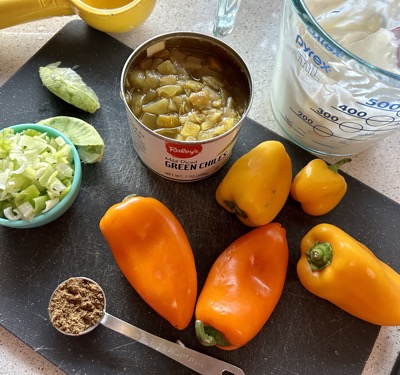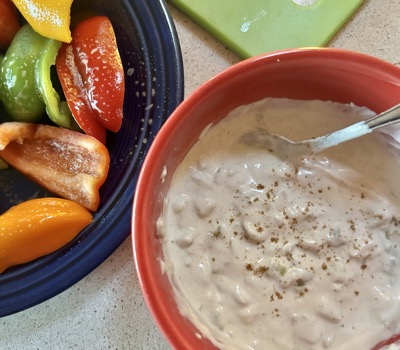
Recipe: Chilies, cumin flavor a double-duty sauce

This yogurt-topped chicken and peppers dish is a great dinner for outdoor dining, or any time of year. Kathy Morrison
The return of warm weather this past week prompted me to break out this recipe, which has been part of my grilling repertoire since the 1990s. But really, it's as easily made with a broiler as with a grill.
However, I love my Weber gas grill, and have been known to use it in any season -- in any weather that doesn't include a deluge.

The pre-adaptation recipe (culled from a long-ago Orange County Register Food section) called the yogurt concoction a "salsa." It's not really, but I'm going to keep the name because it sounds more interesting than "sauce." Plain yogurt is mixed with canned green chilies, scallions, ground cumin and some salt. (I throw in some lime juice if I have it.) Then half the mixture is scooped out and used to marinate the chicken. The other half gets a touch of mayo and is refrigerated to use as the serving sauce.
Food safety note here: Don't ever re-use marinade that has bathed raw meat as a serving sauce! So be sure to separate the mixes before even touching the chicken.
This recipe is appropriate especially during fresh pepper season -- which is now. Any pepper you like to grill works here; I'm in the habit of using multiple colors of bell peppers.
Incidentally, the yogurt serving sauce is not just for the chicken. It's great on the grilled peppers, on grilled zucchini (if you have any zukes left) or over rice, orzo or egg noodles.
One more note: The sauce recipe is best with regular yogurt, but I tried it with the much-thicker Greek yogurt this time. It took all the liquid in the chilies plus some lime juice to loosen it up to sauce consistency, but it did work.
Grilled chicken and peppers with yogurt salsa
Serves 3-4
Ingredients:
1 cup (8 ounces) plain yogurt, full or low-fat, or Greek yogurt
1/4 cup minced green onions (scallions), about 2 stalks, using all the light green and some of the darker green parts
One 7-ounce can chopped or sliced green chilies (mild or hot, to preference)
1 teaspoon or more ground cumin
1/2 teaspoon salt
Fresh lime juice, optional
1 to 1-1/2 pounds boneless, skinless chicken breasts, cut into serving pieces, or boneless thighs
1 tablespoon mayonnaise
For the vegetables:
2 or more colorful bell peppers, or a mix of pepper varieties, or other grillable vegetables such as zucchini and onions, trimmed and cut into grilling-size pieces
Oil spray or cooking oil that can handle high heat
Instructions:

In a medium bowl, stir together the yogurt and the green onions. If using regular yogurt, drain the liquid from the canned chilies before stirring them in. (For Greek yogurt, don't drain the chilies before adding.) Stir in the cumin and salt. Add some lime juice if the mixture still seems too thick. Taste and adjust the level of cumin and salt.
Place about half the yogurt mixture in a large dish or bowl in which to marinate the chicken. To the remaining mixture, which should be about 1 cup, add the mayonnaise, stir, cover and refrigerate until serving time.
If the chicken isn't already in serving sizes, cut it up now. Add the pieces one at a time to the marinade in the dish, turning to coat and piercing with a fork in several places as you turn it. Cover and let the chicken marinate 15 minutes. (Longer is OK. If it's not yet time to start cooking, refrigerate the chicken until then.)
While the chicken marinates, preheat the grill or the broiler to medium high heat.
When ready to cook, place the pepper pieces or other vegetables cut-side-down on a plate and spray with oil spray. Remove the chicken from the marinade and place in one layer on another plate or cutting board. Some of the chilies will cling to the meat; that's OK. Discard the marinade. Spray the chicken with oil spray.
If broiling, place the chicken and vegetables on a large broiler pan. Adjust an oven rack under the broiler so the chicken will be 4 to 5 inches away from the broiler element while cooking.
Adjust the heat to medium on the grill.
Grill or broil the chicken and peppers on both sides until the chicken is fully cooked, about 10-14 minutes, depending on the thickness of the pieces. A grill thermometer comes in handy here; you want the chicken ultimately to reach an internal temperature of 165 degrees. If it's removed from heat at 160 degrees and allowed to rest 5 minutes, it will reach 165 on residual heat.
Remove the peppers early if they seem to be cooking too fast -- they should still be a little crisp.
To serve: Either cut the chicken pieces into 1-inch slices, or serve them whole. Spoon some of the yogurt-mayo salsa over the top and pass the rest of the salsa at the table, along with the peppers and other vegetables.
Great accompaniments: Orzo, noodles or rice; black beans or a corn-black bean salad; green salad.
Comments
0 comments have been posted.Sacramento Digs Gardening to your inbox.
Sites We Like
Garden Checklist for week of July 21
Your garden needs you!
* Keep your vegetable garden watered, mulched and weeded. Water before 8 a.m. to reduce the chance of fungal infection and to conserve moisture.
* Feed vegetable plants bone meal, rock phosphate or other fertilizers high in phosphate to stimulate more blooms and fruiting. (But wait until daily high temperatures drop out of the 100s.)
* Don’t let tomatoes wilt or dry out completely. Give tomatoes a deep watering two to three times a week.
* Harvest vegetables promptly to encourage plants to produce more. Squash especially tends to grow rapidly in hot weather. Keep an eye on zucchini.
* Pinch back chrysanthemums for bushy plants and more flowers in September.
* Remove spent flowers from roses, daylilies and other bloomers as they finish flowering.
* Pinch off blooms from basil so the plant will grow more leaves.
* Cut back lavender after flowering to promote a second bloom.
* It's not too late to add a splash of color. Plant petunias, snapdragons, zinnias and marigolds.
* From seed, plant corn, pumpkins, radishes, winter squash and sunflowers.